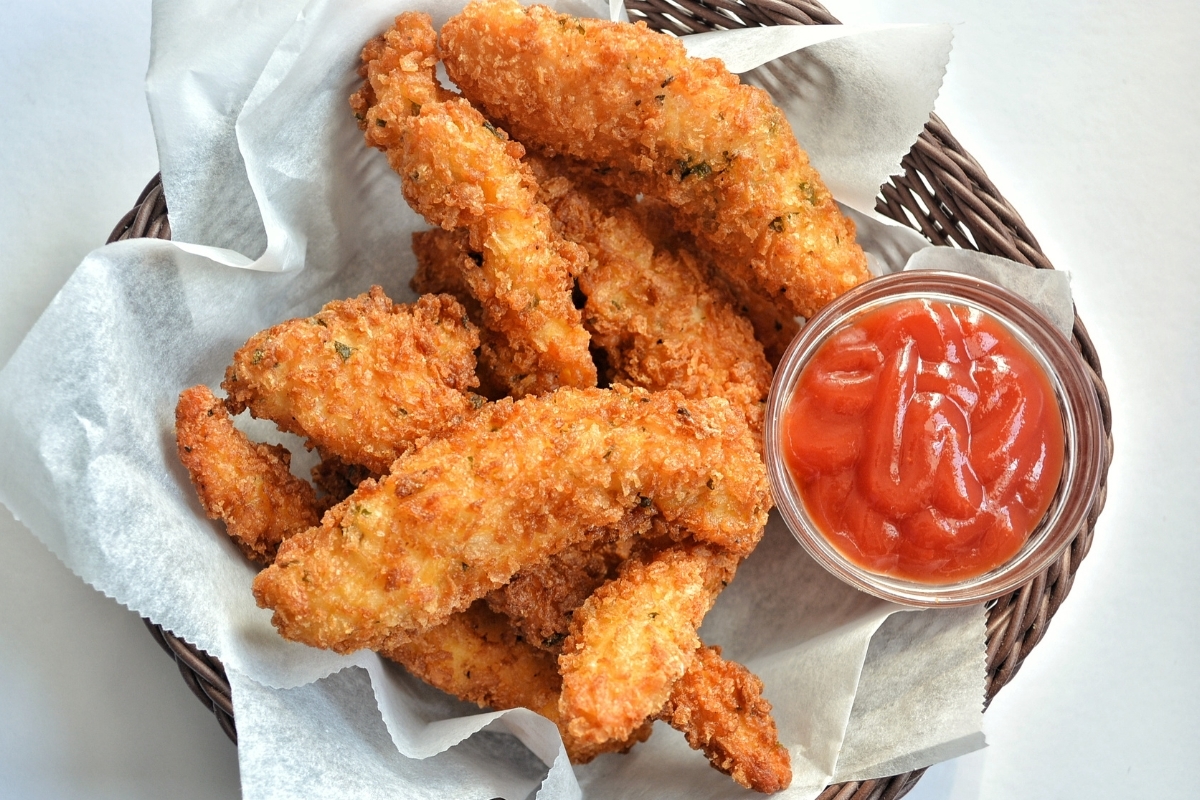Who doesn’t love chicken tenders? They’re crispy, juicy, and downright delicious. But let’s be honest—fried chicken tenders, while tasty, aren’t exactly the healthiest option. Enter baked chicken tenders: the perfect compromise between flavor and nutrition. Whether you’re a busy parent looking for a quick dinner idea or a health-conscious foodie, this guide will show you how to make baked chicken tenders that are so good, you won’t even miss the fryer. Let’s get started!
Table of Contents
What Are Baked Chicken Tenders?
Baked chicken tenders are a healthier twist on the classic fried version. Instead of dunking chicken strips in oil, you coat them in a flavorful breading and bake them in the oven until golden and crispy. The result? Tender, juicy chicken with a satisfying crunch—minus the guilt. Plus, they’re super versatile. You can enjoy them as a snack, a main dish, or even as a salad topper.
“Baked chicken tenders are proof that you don’t need a deep fryer to enjoy crispy, flavorful chicken.”
Why Choose Baked Over Fried?
If you’re wondering why you should ditch the fryer for the oven, here are a few reasons:
- Healthier: Baking uses significantly less oil, cutting down on calories and unhealthy fats.
- Easier Cleanup: No messy oil splatters or lingering fryer smells in your kitchen.
- Kid-Friendly: Baked chicken tenders are a hit with kids, and you can feel good about serving them.
The Health Benefits of Baked Chicken Tenders
Baked chicken tenders aren’t just delicious—they’re also packed with benefits:
- High in Protein: Chicken is a great source of lean protein, which helps build and repair muscles.
- Lower in Fat: Baking reduces the fat content compared to frying, making it a heart-healthy option.
- Customizable: You can control the ingredients, making it easy to accommodate dietary needs like gluten-free or low-carb.
How to Make Baked Chicken Tenders at Home
Ready to make your own baked chicken tenders? Let’s break it down step by step. Don’t worry—it’s easier than you think!

Ingredients You’ll Need
Here’s what you’ll need to make baked chicken tenders for 4 servings:
| Ingredient | Quantity |
|---|---|
| Chicken tenders (or chicken breast cut into strips) | 1 lb |
| All-purpose flour | 1/2 cup |
| Eggs | 2 |
| Breadcrumbs (or panko for extra crunch) | 1 cup |
| Parmesan cheese (grated) | 1/4 cup |
| Paprika | 1 tsp |
| Garlic powder | 1 tsp |
| Salt and pepper | To taste |
| Cooking spray or olive oil | For coating |
Step-by-Step Cooking Instructions
- Prep the Chicken: Pat the chicken tenders dry with a paper towel. Season lightly with salt and pepper.
- Set Up Your Breading Station: In three separate bowls, place the flour, beaten eggs, and a mixture of breadcrumbs, Parmesan cheese, paprika, and garlic powder.
- Coat the Chicken: Dip each tender in the flour, then the egg, and finally the breadcrumb mixture. Make sure each piece is evenly coated.
- Arrange on a Baking Sheet: Place the coated tenders on a baking sheet lined with parchment paper. Lightly spray them with cooking spray or drizzle with olive oil to help them crisp up.
- Bake: Preheat your oven to 400°F (200°C). Bake the tenders for 15-20 minutes, flipping halfway through, until golden brown and cooked through.
Tips for Perfectly Crispy Baked Chicken Tenders
- Use Panko Breadcrumbs: Panko gives the tenders an extra-crispy texture that’s hard to beat.
- Don’t Skip the Parmesan: It adds a savory, cheesy flavor that takes the tenders to the next level.
- Flip Halfway Through: This ensures even browning on both sides.
Nutrition Facts
Here’s a quick breakdown of the nutritional information for baked chicken tenders (per serving):
| Nutrient | Amount |
|---|---|
| Calories | 280 kcal |
| Protein | 30 g |
| Carbohydrates | 15 g |
| Fat | 10 g |
| Fiber | 1 g |
Common Problems When Making Baked Chicken Tenders (and How to Solve Them)
Even the best cooks run into issues sometimes. Don’t worry—we’ve got solutions for the most common baked chicken tender problems. Let’s troubleshoot!
Problem 1: Chicken Tenders Turn Out Soggy
There’s nothing worse than biting into a chicken tender and finding it limp and soggy. Here’s how to avoid this:
- Dry the Chicken Thoroughly: Moisture is the enemy of crispiness. Pat the chicken dry with paper towels before coating it.
- Use a Wire Rack: Place a wire rack on your baking sheet and arrange the tenders on top. This allows air to circulate around the chicken, preventing sogginess.
- Don’t Overcrowd the Pan: Leaving space between the tenders ensures they cook evenly and stay crispy.
Problem 2: Coating Doesn’t Stick to the Chicken
If your breading is falling off, try these tips:
- Pat the Chicken Dry: Moisture can prevent the coating from sticking. Dry the chicken thoroughly before breading.
- Use a Flour Base: The flour helps the egg adhere to the chicken, creating a “glue” for the breadcrumbs.
- Press the Coating On: After dipping the chicken in the breadcrumbs, press gently to ensure the coating sticks.
Problem 3: Chicken Tenders Are Dry or Overcooked
Dry chicken is a big no-no. Here’s how to keep your tenders juicy:
- Don’t Overcook: Chicken tenders cook quickly. Bake them for 15-20 minutes, or until the internal temperature reaches 165°F (74°C).
- Use a Meat Thermometer: This ensures your chicken is cooked perfectly without overdoing it.
- Brining: Soak the chicken in a saltwater brine for 30 minutes before cooking. This helps lock in moisture.
Healthier Alternatives to Traditional Baked Chicken Tenders
Love chicken tenders but want a lighter version? No problem! Here are some healthier twists on the classic recipe.
Gluten-Free Baked Chicken Tenders
For those avoiding gluten, you can still enjoy crispy chicken tenders. Here’s how:
- Use Gluten-Free Flour: Substitute all-purpose flour with a gluten-free blend.
- Gluten-Free Breadcrumbs: Look for gluten-free panko or make your own by crushing gluten-free crackers.
Low-Carb/Keto-Friendly Chicken Tenders
If you’re following a low-carb or keto diet, try this version:
- Use Almond Flour: Replace regular flour with almond flour for a low-carb option.
- Pork Rind Crumbs: Crushed pork rinds make a fantastic keto-friendly breadcrumb substitute.
Vegan “Chicken” Tenders (Using Plant-Based Alternatives)
Yes, even vegans can enjoy chicken tenders! Here’s how:
- Use Plant-Based Chicken: Brands like Beyond Meat or Gardein offer great alternatives.
- Vegan Breading: Use a mixture of breadcrumbs, nutritional yeast, and spices for a flavorful coating.

Creative Variations of Baked Chicken Tenders
Want to mix things up? Try these fun and flavorful variations:
Spicy Buffalo Chicken Tenders
For those who love a kick, toss your baked tenders in buffalo sauce after they come out of the oven. Serve with ranch or blue cheese dressing for dipping.
Parmesan-Crusted Chicken Tenders
Add extra Parmesan cheese to the breadcrumb mixture for a cheesy, savory crust that’s irresistible.
Honey Mustard Glazed Chicken Tenders
Brush the tenders with a mixture of honey and Dijon mustard before baking for a sweet and tangy twist.
Serving Suggestions for Baked Chicken Tenders
Baked chicken tenders are incredibly versatile. Here are some fun and delicious ways to serve them:
Best Dipping Sauces to Pair With Chicken Tenders
- Classic Ranch: A timeless favorite.
- Honey Mustard: Sweet, tangy, and perfect for dipping.
- Barbecue Sauce: Adds a smoky, savory flavor.
Side Dishes That Complement Baked Chicken Tenders
- Sweet Potato Fries: A healthier alternative to regular fries.
- Coleslaw: Adds a refreshing crunch.
- Steamed Veggies: Keep it light and balanced.
Fun Ways to Serve Chicken Tenders for Kids and Adults
- Chicken Tender Wraps: Wrap the tenders in a tortilla with lettuce, cheese, and your favorite sauce.
- Chicken Tender Salad: Slice the tenders and toss them on a bed of greens for a protein-packed meal.
- Chicken Tender Sliders: Serve the tenders on mini buns with pickles and sauce for a fun appetizer.
Frequently Asked Questions About Baked Chicken Tenders
Got questions? We’ve got answers! Here are some common queries about baked chicken tenders:
Can I Use Frozen Chicken Tenders?
Yes, but thaw them completely and pat them dry before breading to ensure the coating sticks.
How Do I Store and Reheat Leftover Chicken Tenders?
Store them in an airtight container in the fridge for up to 3 days. Reheat in the oven or air fryer to maintain crispiness.
Are Baked Chicken Tenders Healthier Than Fried?
Absolutely! Baking uses less oil, reducing the fat and calorie content.
What’s the Best Breading for Crispy Chicken Tenders?
Panko breadcrumbs are the gold standard for extra crunch, but you can also use crushed cornflakes or crackers.
Conclusion: Why Baked Chicken Tenders Are a Must-Try Dish
Baked chicken tenders are more than just a dish—they’re a healthier, tastier way to enjoy a classic favorite. Whether you’re making them for a weeknight dinner or a party appetizer, they’re sure to be a hit. So, what are you waiting for? Grab some chicken and get baking!
“Baked chicken tenders are proof that you can have your crispy chicken and eat it too—without the guilt!”
Now that you’re armed with all the tips, tricks, and recipes, it’s time to make your own baked chicken tender masterpiece. Happy cooking!
For a crispy, healthier alternative to fried chicken, try these Baked Chicken Tenders—juicy, flavorful, and oven-baked to golden perfection. Pair them with a side of Chinese Beef and Broccoli for a balanced meal, or spice things up with Bang Bang Shrimp for a bold flavor combination. Want a hearty sandwich option? Try serving them alongside a Philly Cheesesteak. Enjoy crispy goodness without the guilt! 🍗🔥

